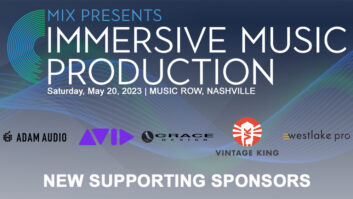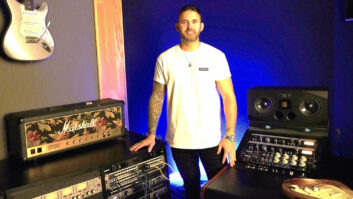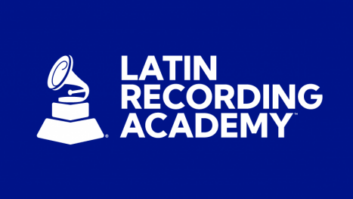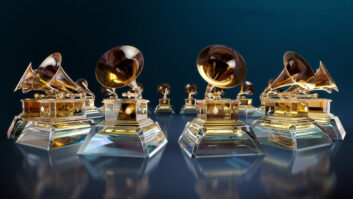I always try to attend AES conventions, yet every year-even as the
exhibits get more elaborate with more manufacturers showing product-I
usually feel left out. As a production sound mixer working primarily in
feature films, the equipment and tools we use have changed very little
in the past 30 years. Most recent advancements in audio have come with
the digital revolution, but digital recording-at least for
production-has only really just begun. So, I went to AES in 1996 and
was overwhelmed by the vast number of exciting DAWs and digital studio
recorders, but, as always, these have limited application for the job I
do. I was somewhat disappointed in not finding that one terrific new
piece of equipment for production sound, when I noticed a little black
box in a small, unassuming booth off in the corner of the vast exhibit
floor.
However, it was not immediately clear exactly what this box was
intended for. It looked somewhat like a CB radio but had buttons on it
labeled Rec and Play and Stop. The person at the booth told me it was a
digital audio recorder that recorded directly to hard disk. I was
intrigued.
I had already been involved in the use of DAT on feature films, well
before anyone else was willing to take the plunge with a totally new
format. Also, at the time, I was the co-owner of a sound transfer
facility, so experimenting with a new format was not so difficult. I
was in control of both sides of the equation: the production recording
on this new format, DAT and the transfers that had to be made to the
then-required format, which was 35mm mag film.
Of course, technology had not advanced to the point where a
full-sized, computer-based DAW, which is terrific for post-production,
could be brought to the set to record production sound. I was sure that
this little box was a controller for some CPU hidden under the table,
but that turned out not to be the case. The entire recorder, battery
and removable hard disk were all enclosed in this small but rugged
unit. I was told that Deva (the name affectionately given to it by its
creator, Glenn Sanders of Zaxcom) was only a prototype and that the
software was far from fully developed. In fact, I believe it was not
functioning as a real recorder at this time. But I was promised that it
would be a real product very soon.
At AES, I had seen a few other devices-also not truly operational or
fully functional at that time-such as the StellaDAT and the Nagra ARES
C re-corder-but Deva really captured my attention. However, I remember
thinking that it would never be a reality. How could Zaxcom (unknown to
me at the time) produce a viable product when the prototype they were
showing looked like something built in a garage and wasn’t
functioning?
A few years later, after I had successfully completed several other
pictures using DAT with only minor difficulties, I saw Deva again. This
time it was a fully functional hard disk recorder, still in the same
little rugged black box, but it offered four tracks of 20-bit digital
audio on a hard disk and ran for three hours on an NP-1 battery. I
realized that soon I would be able to have in production the same
benefits of the digital technology used in the DAWs, and I could throw
it over my shoulder and record sound on location in the middle of the
desert if I needed to!
I have completed two feature films using Deva: The Siege, directed
by Ed Zwick for Twentieth Century Fox, and Fight Club, directed by
David Fincher, also for Fox. I didn’t do all of The Siege but only the
last six weeks of production in Los Angeles; the first 12 weeks were
recorded by Alan Byer in New York. All of Fight Club was shot in Los
Angeles with production audio recorded entirely by the Deva.
My experience with Deva has been wonderful. There have been a few
difficulties, mostly relating to software revisions, but even with the
problems encountered, none were ever fatal-Deva made a perfect 20-bit,
48kHz recording every time. It has been more trouble-free than any
other piece of equipment I have ever used, including my first Nagra
III.
Launching a new format is never easy, but as one of the first to use
DAT in feature films, I knew what needed to be done. For one, I had to
convince the producers that although we were going to be using new
technology, we would also do everything the old way. The old way, in
this case, was DAT, which the producer was comfortable with. If Deva
failed, the producer was confident that nothing would be lost. I also
had to convince the production company that this new technology was not
going to produce any difficulties for them or cost any more money.
As Deva is really a new way of doing things-even more so than
DAT-there were a number of issues to be solved. Both The Siege and
Fight Club were to have normal daily mag transfers done so we could see
projected dailies. At the end of the shooting day, I had to deliver to
the transfer house something that could be transferred to mag film.
Since very few transfer facilities had Deva, Coffey Sound Services (the
distributor) agreed to lend Fox a unit for the transfer room. On The
Siege, I sent in the hard drive and transfers were made to mag by
playing out from the Deva. This all worked perfectly. The hard drives
were cycled back to me to be re-used the next day, and the DAT
cassettes (recorded concurrently on the set) were put on the shelf to
be used as the masters. The DAT, of course, was a 16-bit recording,
somewhat inferior to Deva’s 20-bit, but certainly acceptable during
this experimental phase. This procedure would change on Fight Club as
Deva gained new capabilities.
On Fight Club, we recorded to the hard disk and also, in mirror
mode, to an outboard 2GB Jaz disk. At the end of the day, the Jaz disk
was sent in and transfers of selected takes were made to mag (for
dailies), and a one-to-one of everything was made to a Tascam DA-98
8-track. By transferring to DA-98, the tracks were in a format
accessible to all who needed to deal with them. Currently, the expense
of the Jaz disks makes them unacceptable as a daily consumable media
that the production company would purchase, so the Jaz disks, like the
hard disks, are re-used over and over. This procedure will change as
well, probably by the time I start my next film. Sanders has
demonstrated the Deva recording (in mirror mode) to DVD-ROM. DVD would
allow the production sound department using Deva to send in the DVD
purchased daily by the production company to transfer and to serve as
the archived master for all to use at a cost of approximately $20 per
day.
There has been much discussion in the professional community
concerning the features needed on a location disk recorder, with many
people undecided about what we really require. Do we need 20-bit
recordings? Do we need four tracks? Do we really need random access in
production? Without debating all of the issues here, I can say from
personal experience that it is really neat to be able to play back
instantly any segment or take, on the disk, and then punch Record to
start a new recording with no tape shuttling required and no fear of
recording over previous material.
Another feature built into Deva is the automatic pre-roll that
records up to ten seconds of pre-roll before program material is
actually needed. When you go into Record, Deva automatically puts down
at the head of the segment up to ten seconds of timecode and
program-that’s ten seconds before you even pushed Record! This
ten-second pre-roll has been terrific for telecine sessions, which now
can be done much faster than ever before. As fast as lockup has been in
the past, even with a proper DAT recording with pre-roll, using Deva
has proven to be a real savings in time and money in telecine.
I think the technology represented today by Deva will be the
technology that is used by virtually everyone in production in the near
future. The benefits of digital recording over analog have been well
established, and recording sound files, rather than audio, to a rugged
field recorder with file format compatibility (Deva supports the major
industry-standard file formats, including broadcast .WAV and SDII)
makes all the sense in the world. These sound files, easily
transported, easily copied and easily manipulated by all those involved
in the recording process, make production and post-production work much
more efficient. Multiple access and multiple transfers are all easily
accomplished, and everyone is assured of the preservation of production
quality as everyone is essentially working on the same sound.







